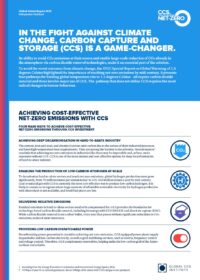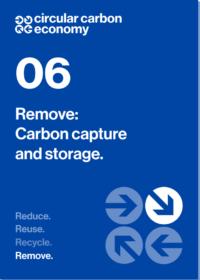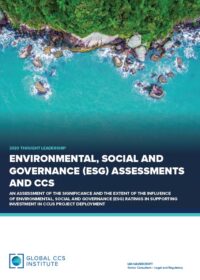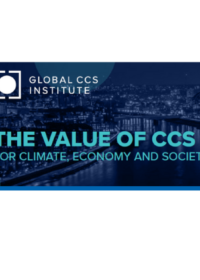Resources
Publications
Our publications, reports and research library hosts over 500 specialist reports and research papers on all topics associated with CCS.
View our Publication Library Disclaimer.
Filter by
The urgency of reaching net-zero emissions requires a rapid acceleration in the deployment of all emissions reducing technologies. Near-zero emissions hydrogen (clean hydrogen) has the potential to make a significant contribution to emissions reduction in the power generation, transportation, and industrial sectors.
As part of the Circular Carbon Economy: Keystone to Global Sustainability series with the Center on Global Energy Policy at Columbia University SIPA, this report explores the potential contribution of blue hydrogen to climate mitigation.
The report looks at:
- Cost drivers for renewable hydrogen and hydrogen produced with fossil fuels and CCS;
- Resource requirements and cost reduction opportunities for clean hydrogen; and
- Policy recommendations to drive investment in clean hydrogen production.
Blue hydrogen is well placed to kickstart the rapid increase in the utilisation of clean hydrogen for climate mitigation purposes but requires strong and sustained policy to incentivise investment at the rate necessary to meet global climate goals.
Disclaimer
The content within the Global CCS Institute Publications, Reports and Research Library is provided for information purposes only. We make every effort and take reasonable care to keep the content of this section up-to-date and error-free. However, we make no claim as to its accuracy, currency or reliability.
Content and material featured within this section of our website includes reports and research published by third parties. The content and material may include opinions and recommendations of third parties that do not reflect those held by the Global CCS Institute.
Technology Readiness and Costs of CCS
29th March 2021
Topic(s): Carbon capture and storage (CCS), Technology readiness
Carbon Capture and Storage (CCS) are essential technologies to help achieve net zero ambitions. The cost of deployment of CO2 capture, transport and storage systems is of vital economic and environmental importance. This importance will continue to increase as the scale and breadth of CCS deployment grows around the world.
As part of the Circular Carbon Economy: Keystone to Global Sustainability series with Columbia University's SIPA Center on Global Energy Policy, this report examines CCS technology from two perspectives: technology readiness and factors influencing costs.
Key drivers of CCS cost include:
- Economies of scale;
- Partial pressure of CO2 in the source gas;
- Energy costs; and
- Technological innovation.
Mature and emerging technologies in carbon capture, transport and storage are surveyed for technological readiness. Technological development will be a key element of driving future cost reductions in CCS and applying CCS to hard-to-abate sectors such as cement, steel and direct air capture.
Disclaimer
The content within the Global CCS Institute Publications, Reports and Research Library is provided for information purposes only. We make every effort and take reasonable care to keep the content of this section up-to-date and error-free. However, we make no claim as to its accuracy, currency or reliability.
Content and material featured within this section of our website includes reports and research published by third parties. The content and material may include opinions and recommendations of third parties that do not reflect those held by the Global CCS Institute.
Carbon Removal with CCS Technologies
26th January 2021
Topic(s): Carbon capture and storage (CCS), Carbon removal, CCS policy, Negative emissions technologies, Policy law and regulation
With the transition to a low-carbon economy steadily underway, CCS is becoming recognised as a tool that complements the wide array of climate approaches being utilised to reach climate neutrality. The role of emission reductions and removals in the mitigation of climate change will change over time. It is widely agreed that emission reductions should be prioritised on the pathway to net zero. This, however, will change once net zero emissions are achieved; net zero is a point on the journey, not the final destination. Carbon removal will become the main driver of climate ambition in the second half of the century.
In this brief, Senior Policy Advisor with the Global CCS Institute, Eve Tamme, explains the dual role of CCS in climate change mitigation, and provides an overview of the two technological carbon removal approaches that use CCS: bioenergy with carbon capture and storage (BECCS) and direct air capture with carbon storage (DACCS). Along with highlighting the varied applications of CCS, this brief also includes a summary of ongoing challenges and opportunities tied to carbon removal related policy development.
Disclaimer
The content within the Global CCS Institute Publications, Reports and Research Library is provided for information purposes only. We make every effort and take reasonable care to keep the content of this section up-to-date and error-free. However, we make no claim as to its accuracy, currency or reliability.
Content and material featured within this section of our website includes reports and research published by third parties. The content and material may include opinions and recommendations of third parties that do not reflect those held by the Global CCS Institute.
The Global Status of CCS report illustrates the critical role carbon capture and storage technology plays in reducing industrial emissions and documents the current and ongoing CCS efforts being undertaken to tackle climate change.
This newly released Global Status of CCS Factsheet highlights measures government and industry can take to achieve cost-effective net-zero emissions through CCS and also points to key milestones reached in the CCS space over the last year.
Download the Global Status of CCS Factsheet below:
- Global Status of CCS - Factsheet - English
- Global Status of CCS - Factsheet - Japanese
- Global Status of CCS - Factsheet - Arabic
- Global Status of CCS - Factsheet - Chinese
Disclaimer
The content within the Global CCS Institute Publications, Reports and Research Library is provided for information purposes only. We make every effort and take reasonable care to keep the content of this section up-to-date and error-free. However, we make no claim as to its accuracy, currency or reliability.
Content and material featured within this section of our website includes reports and research published by third parties. The content and material may include opinions and recommendations of third parties that do not reflect those held by the Global CCS Institute.
The Global Status of CCS Report 2020 demonstrates the vital role of carbon capture and storage technologies (CCS) in reducing emissions to net-zero by 2050 as well as documenting the current status and important milestones for the technology over the past 12 months.
The report provides detailed information on and analyses of the global CCS facility pipeline, international policy perspectives, CO2 storage and the CCS legal and regulatory environment. In addition, four regional updates provide further detail about CCS progress across the Americas, Europe, Asia Pacific and the Gulf Cooperation Council States and a Technology section provides updates on key innovations and applications of CCS.
Disclaimer
The content within the Global CCS Institute Publications, Reports and Research Library is provided for information purposes only. We make every effort and take reasonable care to keep the content of this section up-to-date and error-free. However, we make no claim as to its accuracy, currency or reliability.
Content and material featured within this section of our website includes reports and research published by third parties. The content and material may include opinions and recommendations of third parties that do not reflect those held by the Global CCS Institute.
Replacing 10% of NSW Natural Gas Supply with Clean Hydrogen: Comparison of Hydrogen Production Options
17th November 2020
Organisation(s): Global CCS Institute
Topic(s): Australia, Carbon capture and storage (CCS), Hydrogen
Clean hydrogen is produced by either using renewable energy to produce green hydrogen, or by using fossil fuels with carbon capture and storage (CCS) to create blue hydrogen.
As part of determining the most cost-effective method of creating clean hydrogen, Coal Innovation NSW (CINSW) commissioned the Global CCS Institute to investigate the production costs of replacing 10 per cent of NSW’s natural gas supply with clean hydrogen.
The study considers a scenario where sufficient clean hydrogen is produced to achieve a 10% H2:90% CH4 (natural gas) mix by volume in the NSW gas network and supply the same total energy as is currently supplied by natural gas alone. Options considered were reformation of natural gas with carbon capture and storage (CCS), coal gasification with CCS, and electrolysis of water using renewable electricity. The study found that the best option for the production of clean hydrogen in NSW considering cost, scale, resource use, and emissions abatement outcomes is to utilise coal or gas with CCS.
See NSW Government for further information
Disclaimer
The content within the Global CCS Institute Publications, Reports and Research Library is provided for information purposes only. We make every effort and take reasonable care to keep the content of this section up-to-date and error-free. However, we make no claim as to its accuracy, currency or reliability.
Content and material featured within this section of our website includes reports and research published by third parties. The content and material may include opinions and recommendations of third parties that do not reflect those held by the Global CCS Institute.
Remove: Carbon Capture and Storage
2nd November 2020
Organisation(s): Global CCS Institute
Topic(s): Carbon capture and storage (CCS), CCS policy
Ahead of the 2020 G20 summit, the Global CCS Institute was asked to contribute to the Circular Carbon Economy (CCE) Guide, organised by KAPSARC. In a report titled 'Remove: Carbon Capture and Storage', Alex Zapantis assesses the value of CCS as an effective climate mitigating technology that aims to remove CO2 from the atmosphere and support the establishment of a circular carbon economy.
The report was discussed during a live webinar hosted by KAPSARC.
To read the report in full, click download below.
Disclaimer
The content within the Global CCS Institute Publications, Reports and Research Library is provided for information purposes only. We make every effort and take reasonable care to keep the content of this section up-to-date and error-free. However, we make no claim as to its accuracy, currency or reliability.
Content and material featured within this section of our website includes reports and research published by third parties. The content and material may include opinions and recommendations of third parties that do not reflect those held by the Global CCS Institute.
Environmental, Social and Governance (ESG) Assessments and CCS
16th October 2020
Organisation(s): Global CCS Institute
At the request of the US Department of Energy, The Global CCS Institute undertook an examination of the significance and the extent of the influence of Environmental, Social and Governance (ESG) ratings in supporting investment in CCS project deployment.
The objective of this study was to consider the following five questions:
- How does a company’s ESG rating impact the company?
- How does a company’s CO2 footprint or exposure impact its ESG rating?
- How is CCS considered when the ESG performance of a company with a large CO2 footprint or exposure is rated?
- Do the positive impacts of CCS (if any) on a company’s ESG rating support the business case for investing in or financing CCS?
- How does climate litigation and public policy impact corporate risk and ESG ratings?
The resulting assessment addressed each of these questions, to provide a clearer picture of the complex relationship between the development and scope of ESG ratings, the impacts of a company’s ESG performance and ultimately, whether this will influence future investment in CCS.
Disclaimer
The content within the Global CCS Institute Publications, Reports and Research Library is provided for information purposes only. We make every effort and take reasonable care to keep the content of this section up-to-date and error-free. However, we make no claim as to its accuracy, currency or reliability.
Content and material featured within this section of our website includes reports and research published by third parties. The content and material may include opinions and recommendations of third parties that do not reflect those held by the Global CCS Institute.
De-risking of CCS: A Primer for Investors and Businesses in the United States
28th September 2020
Organisation(s): Global CCS Institute
Topic(s): CCS finance, Risk, United States
Over the past year, the outlook for CCS has been positive, particularly in the United States (US). Thanks to broad bipartisan support at both the federal and state level, CCS in the US has seen growth exceeding that of any other nation.
Additionally, the Institute has seen an increase in new stakeholders looking to engage and explore the role of CCS in their emissions reduction strategies. These new stakeholders include sustainable investors who believe CCS projects can deliver strong returns while achieving environmental goals and mitigating climate change risk.
These new market entrants, however, often share a common concern; the need to de-risk CCS for investment.
This briefing will serve to summarise ongoing work by the Institute to communicate and educate stakeholders on the potential risk characteristics of CCS and to discuss these in the context of de-risking CCS investments and addressing challenges from a US perspective.
Disclaimer
The content within the Global CCS Institute Publications, Reports and Research Library is provided for information purposes only. We make every effort and take reasonable care to keep the content of this section up-to-date and error-free. However, we make no claim as to its accuracy, currency or reliability.
Content and material featured within this section of our website includes reports and research published by third parties. The content and material may include opinions and recommendations of third parties that do not reflect those held by the Global CCS Institute.
In a report co-authored by Columbia University’s Centre on Global Energy Policy (CGEP) and the Global CCS Institute titled ‘Net Zero and Geospheric Return: Actions today for 2030’, findings reveal that climate finance policies and the development of carbon dioxide removal technologies need to grow rapidly within the next 10 years in order to curb climate change and hit net-zero targets.
The report unveils key climate actions required to avoid climate catastrophe:
- With 2020 set to close the hottest decade on record, CO2 emissions need to drop by 50% to achieve net-zero climate goals by 2030
- The rapid deployment of climate mitigating infrastructure needs to occur, including the expansion of CO2 pipelines from the current 8,000 km to 43,000 km by 2030
- Clear climate polices which reduce the financial and regulatory risk of CO2 capture and storage and increase CO2 storage options need to be quickly developed and implemented
A presentation of the report was provided by Global CCS General Manager - Commercial, Alex Zapantis, and Julio Friedmann of Columbia University's Center on Global Energy policy at Climate Week NYC 2020, which can be seen here:
Click below for the full free copy of the report.
Disclaimer
The content within the Global CCS Institute Publications, Reports and Research Library is provided for information purposes only. We make every effort and take reasonable care to keep the content of this section up-to-date and error-free. However, we make no claim as to its accuracy, currency or reliability.
Content and material featured within this section of our website includes reports and research published by third parties. The content and material may include opinions and recommendations of third parties that do not reflect those held by the Global CCS Institute.
The Value of Carbon Capture and Storage (CCS) thought leadership report evaluates the benefits of large-scale investment and deployment of CCS projects, both through an economic and climate change mitigation lens.
This newly released factsheet highlights the key components of the report including:
- The deep decarbonisation of hard-to-abate industrial sectors through the use of CCS technologies
- Widespread job creation tied to CCS deployment
- The delivery of innovation led economic growth
Download the factsheet below and have a quick look at our video for more highlights on the value of CCS.
To read the full Value of CCS thought leadership report, click here.
Disclaimer
The content within the Global CCS Institute Publications, Reports and Research Library is provided for information purposes only. We make every effort and take reasonable care to keep the content of this section up-to-date and error-free. However, we make no claim as to its accuracy, currency or reliability.
Content and material featured within this section of our website includes reports and research published by third parties. The content and material may include opinions and recommendations of third parties that do not reflect those held by the Global CCS Institute.
Global Storage Resource Assessment 2020
2nd July 2020
Organisation(s): Global CCS Institute, Pale Blue Dot
Topic(s): CO2 storage
The CO2 Storage Resource Catalogue is a pioneering initiative to accelerate the deployment of carbon capture, utilization and storage (CCS) by supporting the consistent evaluation of storage resources.
This report, authored by Pale Blue Dot Energy, details the findings of the first assessment for CO2 Storage Resource Catalogue.
Disclaimer
The content within the Global CCS Institute Publications, Reports and Research Library is provided for information purposes only. We make every effort and take reasonable care to keep the content of this section up-to-date and error-free. However, we make no claim as to its accuracy, currency or reliability.
Content and material featured within this section of our website includes reports and research published by third parties. The content and material may include opinions and recommendations of third parties that do not reflect those held by the Global CCS Institute.











